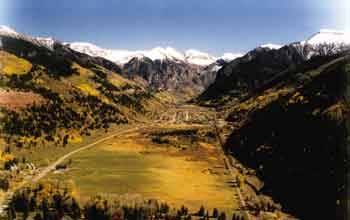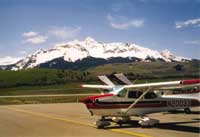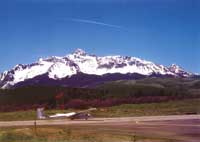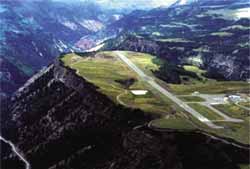|
|

| Telluride |
| A Local Shares His Addiction |

|
Story by Fletcher Anderson
Photos by Gerrit Paulsen
My first view of Telluride years ago was all it took, I instantly knew I had to live here. Nearly everyone who lives here says the same thing: “I saw it and I fell in love.” Some of my neighbors hitchhiked in during the last fading glow of the 60’s and still have the hair and beads to prove it. Most others drove here. A few of us flew in, and if we were not too busy with the approach, got the most awe-inspiring view of all. No matter how firmly rooted they might be elsewhere, most visitors to Telluride return. The initial view is what has hooked us all.
Telluride, Colorado sits high in the San Juan Mountains, at the head of a flat-floored, steep-sided glaciated mountain valley, surrounded on three sides by 14,000-foot peaks. The highest waterfall in Colorado dominates this canyon, with equally stunning views and waterfalls in every other direction. You come upon this grandeur unexpectedly, like suddenly turning the page of a book. Crest the long slow hill on the highway, or bank your plane around the corner of high terrain into valley’s mouth and the dramatic vista suddenly unfolds before you. After a long day of flying immersed in the overwhelming scenery of the most spectacular mountains in America, I still find myself slowing down to take in the view on the two mile drive home from the Telluride airport.
 There is no long strip of development leading to Telluride. The valley floor at the entrance to town remains pristine open space, though constantly threatened. The surrounding mountains and mesas are too rugged to lend themselves to development, except for a few prime areas available to those with the considerable financial means to acquire them. There is no long strip of development leading to Telluride. The valley floor at the entrance to town remains pristine open space, though constantly threatened. The surrounding mountains and mesas are too rugged to lend themselves to development, except for a few prime areas available to those with the considerable financial means to acquire them.
Housing prices are astronomical. Local wages are low. No one cares. People are willing to sacrifice to live in Telluride. Sacrifice is a matter of degree though, as I was reminded during a conversation at a recent dinner party:
“Oh, you have a place here too!” exclaimed my impeccably dressed table-mate, “We just finished building our place. The whole project just got so out of hand. I think we ended up with 15 bedrooms, isn’t that right dear? We are going to see it for the first time tomorrow. If we like it, we plan to come here every Christmas.”
We do have a place here – in fact we don’t have a place anywhere else – and since we work in aviation, you might have already guessed correctly we have fewer than 15 bedrooms.
The dinner conversation soon turned to getting to Telluride, a frequent topic in this isolated corner of Colorado: “Oh, you have a plane! So do we! What’s ours called again darling? A Challenger?”
Undaunted, I casually responded, “Oh gosh, I can’t remember what ours are called. We have four of them.” This is mostly true, we do have four of them: two gliders, a tow plane, and a Cessna 172 trainer. But I do know exactly what they are called, exactly where most of the nuts and bolts are on every one of them, and you could probably carry all four of them at once in a Challenger and still have room for the catering.
“But you actually flew right in here!” my table-mate continued, “Our pilots simply refused to land at the Telluride airport, we had to get a taxi from Montrose.” Now, at last, I really am one-up. “Oh really?” I gloat, “All our pilots fly in here all the time.” (They have to – they live here.)
While this dinner conversation is almost verbatim, the impression it creates about the people of Telluride is not completely accurate.
There are indeed 15-bedroom and larger second homes in the vicinity. There are at least a couple of big name Hollywood stars who charter a helicopter to meet their Gulfstream on the ramp and are whisked up to their front yard – a mere minute and a half away by car. At peak vacation periods, there can be more than twenty large private jets on the ramp, with a greater number ferried elsewhere after dropping passengers because there is no more ramp space available. That’s a lot of jets for a town of less than 2000 people!
Vast fortunes are very conspicuously displayed. There are times when Telluride looks very much like a second Aspen. But it isn’t true.
Aspen and environs has a peak season population of over 100,000 people. Telluride has a year round population of under 2,000 which swells to only about 6,000 during the busiest weeks of summer. 90 percent of Aspen’s work force commutes from outside the county, much less the town. In contrast, 80 percent of Telluride’s work force lives in metropolitan Telluride, or relatively nearby.
 For a visitor, the experiences are worlds apart. Aspen expects employees to do their jobs quietly and then politely leave. Working residents are not encouraged to mingle with guests and second homeowners… and increasingly; both groups prefer it that way. But Telluride’s workforce isn’t going anywhere at the end of the day except perhaps downtown for a cold beer. The chairlift loader, the waitress at breakfast, the charter pilot, the ramp people who fueled your plane, the maid at the hotel; most of them live here. You will run into them downtown. Chances are good they will recognize you, and …imagine this at a resort… chances are good they will say hello in a very cheerful voice and mean it! It’s a small community. People live here on purpose, generally taking a huge pay cut and suffering a much higher cost of living to do so. If the ramp people are polite, it is genuine. They are definitely not in awe of you because you flew here in an airplane. They’re glad they’re here, they’re glad you’re here. It is an atmosphere, which fosters goodwill and mutual respect between visitors and residents. For a visitor, the experiences are worlds apart. Aspen expects employees to do their jobs quietly and then politely leave. Working residents are not encouraged to mingle with guests and second homeowners… and increasingly; both groups prefer it that way. But Telluride’s workforce isn’t going anywhere at the end of the day except perhaps downtown for a cold beer. The chairlift loader, the waitress at breakfast, the charter pilot, the ramp people who fueled your plane, the maid at the hotel; most of them live here. You will run into them downtown. Chances are good they will recognize you, and …imagine this at a resort… chances are good they will say hello in a very cheerful voice and mean it! It’s a small community. People live here on purpose, generally taking a huge pay cut and suffering a much higher cost of living to do so. If the ramp people are polite, it is genuine. They are definitely not in awe of you because you flew here in an airplane. They’re glad they’re here, they’re glad you’re here. It is an atmosphere, which fosters goodwill and mutual respect between visitors and residents.
Remember the dinner party? Some of the people in the room are flown around in Challengers; some of them struggle at hourly wage jobs in order to realize the dream of living in these mountains. Everyone’s choices are respected, even admired. Multi-millionaires and hourly-wage workers mingle comfortably here in Telluride.
It is undeniably expensive to stay here, but not to the degree people expect. For instance, at the height of Christmas vacation, a room at the Peaks Hotel (800-789-2220, thepeaksresort.com) near the Mountain Village end of the gondola will set you back $540, while the Columbia Hotel right at the other base of the same gondola in Telluride charges $285 for the equivalent room, but without the world class spa. In fall or spring off-season, the same rooms are just over $100, and those are the region’s premier hotels. Incidentally, two of our pilots own and manage the Columbia Hotel (800-201-9505, columbiatelluride.com) and offer visiting pilots a 10 percent room discount. The gondola itself is free, and a key component of the region’s mass transit system, allowing easy access between the world-class views and facilities of the Mountain Village set high on a ridge above town, and the historic charm of Telluride in the valley.
There are a dozen-odd lodges and hotels in Telluride and Mountain Village, several Bed and Breakfasts, plus numerous short-term condominium rentals. Telluride Central Reservations is a good place to start (970-728-4431).
What to do here? Visitor and resident alike, Telluride has a very active population, and a vibrant outdoor industry.
Of course you could ski. (Spotted the ski runs just off the right wing tip on base for runway 27, didn’t you?) Telluride’s ski lift tickets are the second highest priced in the country, even though most magazines rate the skiing as just average. It’s the scenery that’s unequaled. Ski area expansion to be phased in over the next five years will nearly double the size of the ski area, adding mostly much needed blue terrain. Snow making installed last summer has eliminated the early season low snow problem.
After a day of skiing or mountain biking you might enjoy a meal at Campagna. This Tuscan style Italian restaurant has been voted best in Colorado three years in a row, but is widely known to be far above that standard (970-728-6190). The maitre’de is named Joline, an instrument rated pilot who has flown her Telluride-based Cessna 172 to both coasts and the Caribbean. Her husband Vincent is the chef, and is a commercial pilot and commercial glider pilot. You can choose from a couple of pages of more restaurants. Your best bet for the proverbial $100 hamburger would probably be Eagles Bar on Main Street (970-728-0886). For breakfast, join the throng outside Sofio’s, also on Main (970-728-4882). If you don’t like my picks for restaurants, there are over a dozen more choices, all well recommended.
You can helicopter ski (970-728-4904). There are river trips, horseback rides, golf, tennis, jeep tours and rentals, guided mountaineering (970-728-3895). You can hike at any time of year, or cross-country ski for free in winter on trails in both towns, and up on Lizardhead Pass to the south. You can shop. Not, by the way, at big-name mass-marketing chains. Nearly all Telluride shops are unique to here, not franchises from somewhere else.
 Oh, and did I forget this? You can also fly with us! Oh, and did I forget this? You can also fly with us!
Telluride Soaring is the highest commercial glider operation in the world, offering hour-long rides over the mountains as well as instruction through the commercial glider level. The experience of floating quietly above 14,000 foot peaks, and then actually climbing higher without an engine is better experienced than described. Call us at 970-728-5424 to reserve a slot.
If flying with a motor is more to your liking, drop by Mountain Aviation Services. This is the second highest flight school in America (after Leadville, Colorado). We could go for a scenic flight, but if you are already a pilot, you might prefer to be at the controls. Mountain Flying instruction is our principal activity year round (970-728-1728).
When to visit? Ski season is an obvious choice. You can ski then. Actually though, summer is a busier season for the town of Telluride, but not for Mountain Village at the ski-area base, which is a virtual ghost town/construction site in summer. Fall, meaning September and October, often has the most pleasant weather, best flying, and very small crowds. November before Thanksgiving is usually poor weather. Spring after the ski area closes in mid April is mud season. Town is deserted until Memorial Day weekend, most businesses are closed, and most residents have gone elsewhere on vacation.
People visit Telluride for the outdoor activities, the fine restaurants, and the luxurious accommodations. Be warned though, your first glimpse of this unparalleled mountain scenery may be addictive.
|
|
Flying to Telluride
|
 At an elevation of 9080 feet msl, Telluride Regional Airport (TEX) is the highest commercial airport in America. Pattern altitude is a lofty 10,200 feet. (No wonder pilots who land here are eager to buy the T-shirt to prove it!) The town of Telluride is five miles away. There are several cab companies (including Mountain Limo 888-546-6894 and Telluride Express 888-212-TAXI) and two rental car companies (Budget on airport 800-221-2419, and National in town 970-728-9380) that serve the airport. Most hotels have free shuttle service, and there is a crew car. There is a landing fee of $1 per 1000 lbs. aircraft max gross weight. Hangar space is sometimes available. Call the airport for more information at 970-728-5051 or visit tellurideairport.com. At an elevation of 9080 feet msl, Telluride Regional Airport (TEX) is the highest commercial airport in America. Pattern altitude is a lofty 10,200 feet. (No wonder pilots who land here are eager to buy the T-shirt to prove it!) The town of Telluride is five miles away. There are several cab companies (including Mountain Limo 888-546-6894 and Telluride Express 888-212-TAXI) and two rental car companies (Budget on airport 800-221-2419, and National in town 970-728-9380) that serve the airport. Most hotels have free shuttle service, and there is a crew car. There is a landing fee of $1 per 1000 lbs. aircraft max gross weight. Hangar space is sometimes available. Call the airport for more information at 970-728-5051 or visit tellurideairport.com.
There are a few things visiting pilots should be aware of. The same stunning scenery that makes Telluride such a great place to visit or live also creates significant challenges to pilots. Although it looks like this airport is just on the edge of the mountains, from a flying standpoint you have entered the mountains at least seven miles west of the airport. On a calm day, this is just another nice long runway with exceptional scenery; but there are days when very strong mountain flying skills are a must in order to land at Telluride Regional.
The airport is surrounded on three sides by nearby, very high terrain (over 14,000 msl), therefore most pilots approach Telluride from the west over the relatively lower terrain. Generally speaking, all approaches are from the west, and all departures to the west in order to avoid the high terrain and for noise abatement over town. This means opposite direction traffic is the norm, not the exception. Wind permitting, land on 09 and depart on 27. There is plenty of room to fly a standard traffic pattern to land 27, even for a Gulfstream – the mountains look closer than they really are. On those rare occasions when the wind forces a 09 departure, turn back to the west immediately as soon or sooner than safe altitude allows! Flying any further east than the east end of the runway in those conditions means you are flying into very strong sinking air and into rising terrain in a box canyon.
The runway sits on top of a mesa with cliffs off either end, and a cliff parallel to and near the south side. Westerly winds over 20 knots and east or south winds as low as 10 knots can produce appreciable low level wind sheer when they are deflected up the cliff faces and then form a rotor right over the runway. South winds are a particular concern. Strong southerly winds can venturi through Lizardhead Pass to the south and blast right up the cliffs into a rotor directly over the pavement. A steeper than normal approach can give you a little extra room over the cliff edge, and in a pinch you could convert some of that extra altitude into airspeed. In strong south conditions, small aircraft do well to divert to Montrose or Cortez airports, which have south facing runways and no nearby terrain to produce turbulence.
Density altitude is a factor here year round, but in summer density altitudes in excess of 12,000 feet can be encountered. The west end of the runway is 100 feet higher than the dip in the center. It is crucially important to check the operator’s manual for your aircraft’s ability to takeoff and climb at that altitude before trying it. At these altitudes, a standard engine Cessna 172 or Piper Cherokee becomes a two-seat airplane. Even high performance aircraft surprise their pilots with how much of the 6870-foot runway disappears before breaking ground.
Summer midday convective turbulence is the norm here, as it is everywhere else in the mountains, and indeed, the entire Southwest. In a small plane, it is often advisable to avoid that part of the day. As with virtually all mountain airports, before 10:00 AM, there is usually a temperature inversion trapped in the valley and winds are mild if not outright calm. After about 4:00 PM, the angle of the sun is lower again and convective activity dies down. Even in winter, on a day when strong winds are predicted, you can anticipate much milder conditions in the early morning.
 There is a localizer DME approach to runway 09, as well as a VOR approach from the Cones VOR (ETL) out to the west, and a GPS approach. As instrument procedures go, these are relatively uncomplicated ones. Nevertheless, for small aircraft, the best advice is not to attempt to fly instruments in the mountains. Minimum on route altitudes for airways east of Telluride are over 16,000 msl. This means icing conditions can be encountered any month of the year. In a small aircraft, you could find yourself unable to descend below the icing layer because of the high terrain, while unable to climb above it because of your aircraft’s service ceiling. The localizer approach brings you to within a mile of the runway, but only allows you to descend to 2200 feet agl. Even at that height, you are still flying right into a box canyon thousands of feet below nearby mountains, and getting the missed approach procedure wrong could be a problem. In the event that you cannot get into Telluride on instruments, Montrose has an ILS that gets you down to 200’ over the pavement with no nearby high terrain. Note that Denver Center (125.35) cannot communicate with you until you are about five miles west of the Telluride airport and above 12,000msl. Denver FSS is available via the Telluride RCO (122.15) at the run up area for 27. There is a localizer DME approach to runway 09, as well as a VOR approach from the Cones VOR (ETL) out to the west, and a GPS approach. As instrument procedures go, these are relatively uncomplicated ones. Nevertheless, for small aircraft, the best advice is not to attempt to fly instruments in the mountains. Minimum on route altitudes for airways east of Telluride are over 16,000 msl. This means icing conditions can be encountered any month of the year. In a small aircraft, you could find yourself unable to descend below the icing layer because of the high terrain, while unable to climb above it because of your aircraft’s service ceiling. The localizer approach brings you to within a mile of the runway, but only allows you to descend to 2200 feet agl. Even at that height, you are still flying right into a box canyon thousands of feet below nearby mountains, and getting the missed approach procedure wrong could be a problem. In the event that you cannot get into Telluride on instruments, Montrose has an ILS that gets you down to 200’ over the pavement with no nearby high terrain. Note that Denver Center (125.35) cannot communicate with you until you are about five miles west of the Telluride airport and above 12,000msl. Denver FSS is available via the Telluride RCO (122.15) at the run up area for 27.
Line-of-sight limitations also affect other communications at Telluride. While you can get AWOS (118.325) and Unicom/CTAF (123.0) well out to the west, you cannot get either when you are quite near the airport but on the other side of the ridges to the north, east, or south. Approaching from the north, you cannot hear departing traffic until you round the corner three miles west, so don’t cut the corner too tight.
|
| Fletcher Anderson lives in Telluride, Colorado, and is the operator of Telluride Soaring, the world’s highest glider operation, and Mountain Aviation Services, the second highest flight school in America. He has over 4000 hours mountain flying experience and has given over 1000 hours of mountain flying instruction. |
Click here to return to the beginning of this article.  |
|